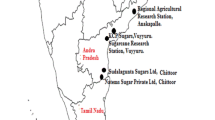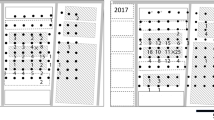Abstract
The Mexican rice borer, Eoreuma loftini (Dyar) (Lepidoptera: Crambidae), is an invasive pest of sugarcane, Saccharum spp., rice, Oryza sativa L., and other graminaceous crops in the United States. Traps baited with the synthetic female sex pheromone of E. loftini are used for monitoring and management of this invasive pest. However, the active space, or radius of attraction, of these traps is not known. Two field experiments examined the effect of intertrap distance on trap captures with hexagonal arrays of traps deployed in rice stubble habitat in Texas (2011) and Louisiana (2013). Trap capture increased with increasing intertrap distance. Trap interference occurred at intertrap distances ≤50 m in the 2011 experiment. Results from the experiment conducted in 2013 indicate that trap interference occurs at intertrap distances of 50 m, but not at distances ≥100 m. These results suggest that under field conditions, E. loftini pheromone traps attract males from distances of 50–100 m. The active space of pheromone traps also was examined under controlled wind conditions by direct observation of male response to detection of the female sex pheromone. Eoreuma loftini males responded to the pheromone blend by becoming active, fanning their wings, and rapidly walking in circles. The mean distance from the pheromone source at which males responded was 47.6 m. This work provides the first documentation of active space for traps baited with female sex pheromone for a crambid species, and these data will improve pheromone trap deployment strategies for E. loftini monitoring and management.



Similar content being viewed by others
References
Brown H, Wood LT, Shaver TN, Worley J (1988) Behavioral responses of male Eoreuma loftini (Lepidoptera: Pyralidae) to ovipositor extracts. J Econ Entomol 81:184–188
Cruz-García H, López-Martínez V, Alia-Tejacal I, Guillén-Sánchez D, Andrade-Rodrígues M, Álvarez-Vargas JE, Campos-Figueroa M (2016) Population dynamics of Mexican rice borer, Eoreuma loftini (Dyar), using a pheromone trap system in sugarcane, Saccharum officinarum L., in Morelos, México. Southwest Entomol 41:15–20
David CT, Kennedy JS, Ludlow AR, Perry JN, Wall C (1982) A reappraisal of insect flight towards a distant, point source of wind-borne odor. J Chem Ecol 8:1207–1215
Elkinton JS, Cardé RT (1984) Odor dispersion. In: Bell WJ, Cardé RT (eds) Chemical ecology of insects. Chapman and Hall, London/New York, pp. 73–91
Elkinton JS, Cardé RT (1988) Effects of intertrap distance and wind direction on the interaction of gypsy moth (Lepidoptera: Lymantriidae) pheromone-baited traps. Environ Entomol 17:764–769
Elkinton JS, Schal C, Ono T, Cardé RT (1987) Pheromone puff trajectory and upwind flight of male gypsy moths in a forest. Physiol Entomol 12:399–406
Hayden, JE (2012) Mexican rice borer, Eoreuma loftini (Dyar) (Lepidoptera: Crambidae: Crambinae) in Florida. Pest Alert Nov 13, 2012. Florida Depart Ag and Consum Serv, Div Plant Industry
Karandinos MG (1974) Recovery of Synanthedon pictipes males released at various distances downwind of sex pheromone traps. Environ Entomol 3:923–926
Legaspi JC, Legaspi BC Jr, King EG, Saldaña RR (1997) Mexican rice borer, Eoreuma loftini (Lepidoptera: Pyralidae) in the lower Rio Grande Valley of Texas: its history and control. Subtrop. Plant Sci 49:53–64
Linn CE Jr, Campbell MG, Roelofs WL (1987) Pheromone components and active space: what do moths smell and where do they smell it? Science 237:650–651
Martinez AJ, Baird J, Holler T (1988) Mass rearing sugarcane borer and Mexican rice borer for production of parasites Allorhogus pyralophagus and Rhaconotus roslinensis. USDA-APHIS-PPQ, APHIS:83–81
Murlis J, Jones CD (1981) Fine-scale structure of odor plumes in relation to insect orientation to distant pheromone and other attractant sources. Physiol Entomol 6:71–86
Murlis J, Elkinton JS, Cardé RT (1992) Odor plumes and how insects use them. Annu Rev Entomol 37:505–532
Nakamura K (1976) Active space of the pheromone of Spodoptera litura and the attraction of adult males to the pheromone source. Proc Symp Insect Pheromones and their Applications, Nagoaka and Tokyo 1976:145–155
Nakamura K, Kawasaki K (1977) Active space of the Spodoptera litura (F.) sex pheromone and the pheromone component determining this space. Appl Entomol Zool 12:162–177
Reay-Jones FPF, Wilson LT, Way MO, Reagan TE, Carlton CE (2007) Movement of the Mexican rice borer (Lepidoptera: Crambidae) through the Texas rice belt. J Econ Entomol 100:54–60
SAS Institute (2008) User’s manual version 9.2. SAS Institute, Cary http://support.sas.com/rnd/app/da/glimmix.html
Shaver TN, Brown HE, Williams HJ, Wood LT, Worley J (1988) Components of female sex pheromone of Eoreuma loftini Dyar. J Chem Ecol 14:391–399
Shaver TN, Brown HE, Hendricks DE (1990) Development of pheromone lure for monitoring field populations of Eoreuma loftini (Lepidoptera: Pyralidae. J Chem Ecol 16:2393–2399
Shaver TN, Brown HE, Bard JW, Holler TC, Hendricks DE (1991) Field evaluations of pheromone-baited traps for monitoring Mexican rice borer (Lepidoptera: Pyralidae. J Econ Entomol 84:1216–1219
Texas Commission of Environmental Quality (2002) Wind roses: illustrations of wind direction movement from particular Texas cities from 1984 to 1992, used to help predict long term air quality. http://www.tceq.state.tx.us/airquality/monops/windroses.html. Accessed 4 April 2016
University of Florida (2015) Mexican rice borer… an introduction. (http://erec.ifas.ufl.edu/mexican_rice_borer/index.shtml). Accessed 5 Apr 2016.
Van der Kraan C, Van Deventer P (1982) Range of action and interaction of pheromone traps for the summerfruit tortrix moth, Adoxophyes orana (F.V.R. J Chem Ecol 8:1251–1262
Wall C, Perry JN (1978) Interactions between pheromone traps for the pea moth, Cydia nigricana (F.). Entomol Exp Appl 24:155–162
Wilson BE (2016) Mexican rice borer pheromone trap efficacy and role in invasive species monitoring and pest management. Dissertation, Louisiana State University, Baton Rouge
Wilson BE, Showler AT, Beuzelin JM, Reagan TE (2012) Improved chemical control for the Mexican rice borer (Lepidoptera: Crambidae) in sugarcane: larval exposure, a novel scouting method, and efficacy of a single aerial insecticide application. J Econ Entomol 105:1998–2006
Wilson BE, Hardy T, Beuzelin JM, VanWeelden MT, Reagan TE, Stout MJ, Miller R, Carlton CE (2015) Expansion of the Mexican rice borer into rice and sugarcane in Louisiana. Environ Entomol 40:757–766
Windfinder (2016) Wind and weather statistics: Lake Charles airport. http://www.windfinder.com/windstatistics/lake_charles. Accessed 4 Apr 4 2016
Witzgall P, Kirsch P, Cork A (2010) Sex pheromones and their impact on pest management. J Chem Ecol 36:80–100
Acknowledgments
The authors thank cooperating rice farmers John Jenkins, Bill Dishman, Habetz Bros. and others for allowing use of their land. Gratitude also is expressed to Jimmy Meaux of the Calcasieu Parish Extension Service and M.O. Way of Texas A & M AgriLife for assistance in selection of research sites. Additional thanks are in order for Matt VanWeelden and Narinder Heer for technical assistance. Appreciation is expressed to Caitlin King for assistance with the figures. The authors thank the United States Department of Agriculture NIFA (grant 2011-67009-30132), the EPA Strategic Agricultural Initiative Program (0348-0046), the EPA Regional Agricultural IPM Program (PE-00F48501) and the American Sugar Cane League for funding. This manuscript has been approved for publication by the Louisiana State University Agricultural Center (Manuscript Number: 2016-234-27250).
Author information
Authors and Affiliations
Corresponding author
Ethics declarations
Conflict of Interest
The authors declare that they have no conflict of interest.
Rights and permissions
About this article
Cite this article
Wilson, B.E., Beuzelin, J.M., Allison, J.D. et al. The Active Space of Mexican Rice Borer Pheromone Traps. J Chem Ecol 42, 888–895 (2016). https://doi.org/10.1007/s10886-016-0767-y
Received:
Revised:
Accepted:
Published:
Issue Date:
DOI: https://doi.org/10.1007/s10886-016-0767-y




